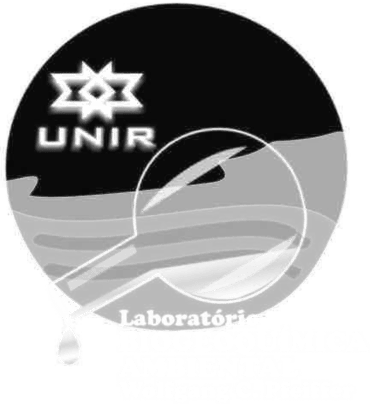Publicações 2015
Bioaccumulation of methylmercury, fish, Amazon, Qualidade da água, Trace metals, Chromium, Fish
ARTIGOS & PERIÓDICOS
Bioaccumulation of methylmercury in fish tissue from the Roosevelt River, Southwestern Amazon basin
Marcelo Rodrigues dos Anjos, Nadja Gomes Machado, Maria Eliana Peixoto da Silva, Wanderley Rodrigues Bastos, Márcio Rodrigues Miranda, Dario Pires de Carvalho, Marília Higino Mussy, Igor Bruno Barbosa de Holanda, Marcelo Sacardi Biudes, João Ânderson Fulan
Abstract: Mercury is a major pollutant in the Amazon River system, and its levels in fish and human hair are usually above the limit recommended by health agencies. The objective of this study was to analyze the methylmercury (MeHg) concentration in fish tissue from the Roosevelt River. The river's water velocity, depth, pH, temperature, electrical conductivity, dissolved oxygen and substrate type were measured, and fifty specimens distributed in 14 fish species were collected. A total of 64.3% of the sampled species were of the order Characiform and 71.4% of the species were carnivores. Fifty percent of the species had MeHg concentrations above threshold limit (Hg-T 0.5 mg kg⁻¹) established for food by the World Health Organization. Cichla monoculus had the highest value of MeHg (2.45 mg kg⁻¹). The MeHg concentration in fish varied according to dietary habits. The study also found bioaccumulation of MeHg in fish tissue in the following descending order: carnivorous > detritivorous > frugivore. Low significant correlations were found between fish weight or length and MeHg. Further studies on MeHg contamination are recommended in tissues of fish consumed in human riverine communities in the Roosevelt River Basin.
Avaliação da qualidade da água subterrânea: estudo de caso de Vilhena – RO
Gislayne Alves Oliveira, Elisabete Lourdes do Nascimento, Ana Lúcia Denardin da Rosa, Leidiane Caroline Lauthartte, Wanderley Rodrigues Bastos, Calina Grazielli Dias Barros, Eloiza Ruschel Cremonese, Amanda Quinhones Bento, Olaf Malm, Jordana Georgin, Adrielen Moraes Corti
Abstract: As águas subterrâneas do Aquífero Parecis (AP) representam a única fonte explorada para o abastecimento público de água potável do município de Vilhena - RO. Nesse sentido, a avaliação da qualidade da água determinada por análises físicas, químicas e microbiológicas, podem fornecer subsídios para a compreensão das condições da água consumida. No presente estudo, foram realizadas duas coletas de água subterrânea em 12 poços distribuídos na cidade: a primeira no período de estiagem (seca), em agosto de 2013; e a outra no período chuvoso, em dezembro de 2013. Os parâmetros analisados foram os constituintes iônicos (F⁻, Cl⁻, NO2⁻, Br-, NO3⁻, PO4⁻³, SO4⁻², Na⁺, NH3⁺, K⁺, Ca²⁺ e Mg²⁺), os quais foram quantificados pela técnica de cromatografia iônica, enquanto que para as análises microbiológicas, o método utilizado foi o de membranas filtrantes em meio cromogênico. Os parâmetros pH e turbidez foram medidos por meio de pHmetro e turbidimetro portáteis. Os resultados apresentaram valores abaixo dos limites estabelecidos pela Resolução CONAMA 396/2008 e Portaria do MS 2.914/2011 para a turbidez e praticamente todos os constituintes iônicos, com exceção do nitrato (6 poços) e de amônia (1 poço), além de um pH ácido. O período chuvoso apresentou maior contaminação por coliformes totais e Escherichia coli que o período de estiagem, podendo estar associado às más condições dos poços, além de ser um aquífero livre, facilitando o escoamento de possíveis contaminantes. Em função dos resultados, destaca-se a importância do monitoramento constante da qualidade da água nas comunidades usuárias de fontes alternativas, evitando problemas à saúde humana.
Assessment of trace metals in Amazonian fish exposed to untreated urban sewage: high chromium concentrations in fish tissues
Eduardo Araujo de Sousa, Márcio Rodrigues Miranda, Marília Hauser dos Santos, Walkimar Aleixo Costa Júnior, Leidiane Caroline Lauthartte, Marília Higino Mussy, Igor Bruno Barbosa de Holanda, Wanderley Rodrigues Bastos
Abstract: The aim of this study was to evaluate the quality of fish meat in relation to inorganic contaminants (Zn, Pb, Cu, Cr, Ni and Hg), following the Brazilian Health Surveillance Agency (ANVISA) standards in five Amazonian fish exposed to untreated urban sewage. Trace metal concentrations were evaluated in the muscle tissues of Schizodon fasciatus (herbivorous), Potamorhina latior (detritivorous), Triportheus angulatus (omnivorous), Plagioscion squamosissimus (carnivorous) and Rhaphiodon vulpinus (piscivorous), sampled upstream and downstream of Santo Antônio's Hydroelectric Dam, Madeira River (Porto Velho City, Brazil). An acid chemical digestion was used to extract trace metals from the tissues, and atomic absorption spectrometry methods were used to quantify the trace metal concentrations. Fish samples showed values above allowed limits for Cr (0.10 mg.kg⁻¹), except in Plagioscion squamosissimus (0.09 mg.kg⁻¹). Potamorhina latior specimens sampled downstream showed higher values for Cr (p<0.0001) than specimens sampled upstream. This result may indicate that untreated urban sewage discharged into the river downstream is influencing the Cr concentrations. As only Cr exceeded the allowed value for consumption, the estimated daily intake of Cr in the Brazilian urban and riverine population was calculated based on their fish consumption for each species sampled upstream and downstream. Estimates of daily intake of Cr were higher in fish sampled downstream than upstream, and were 13 times higher in the riverine population than in the Brazilian urban population.





